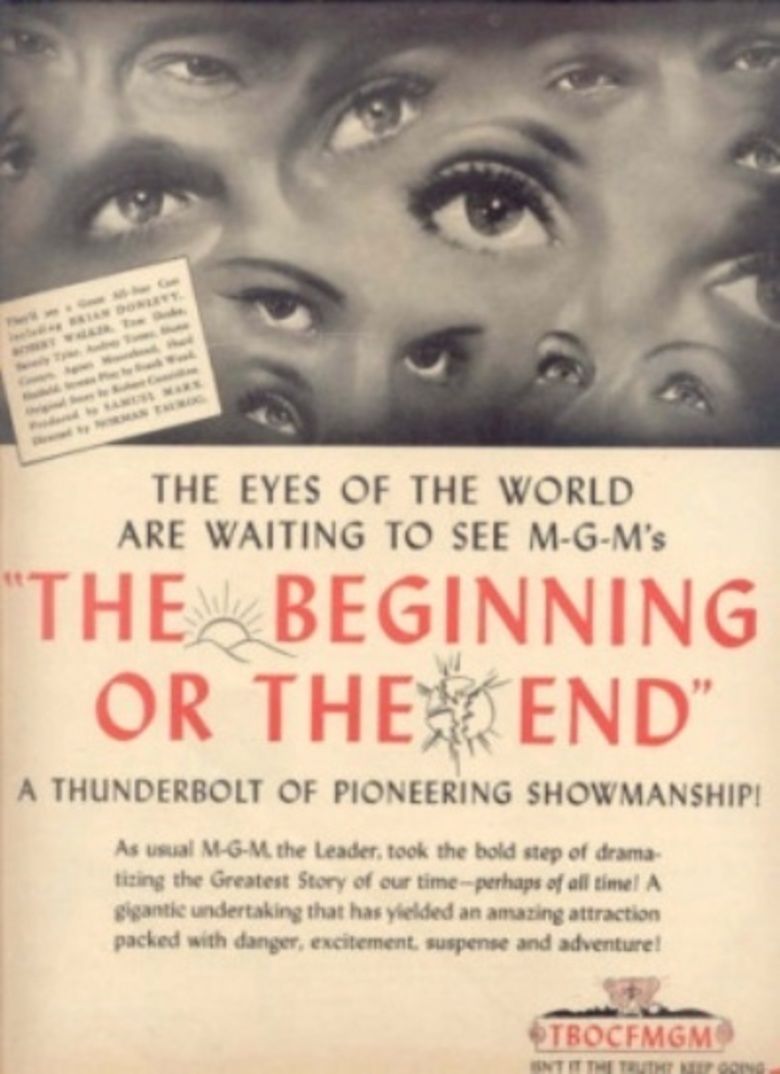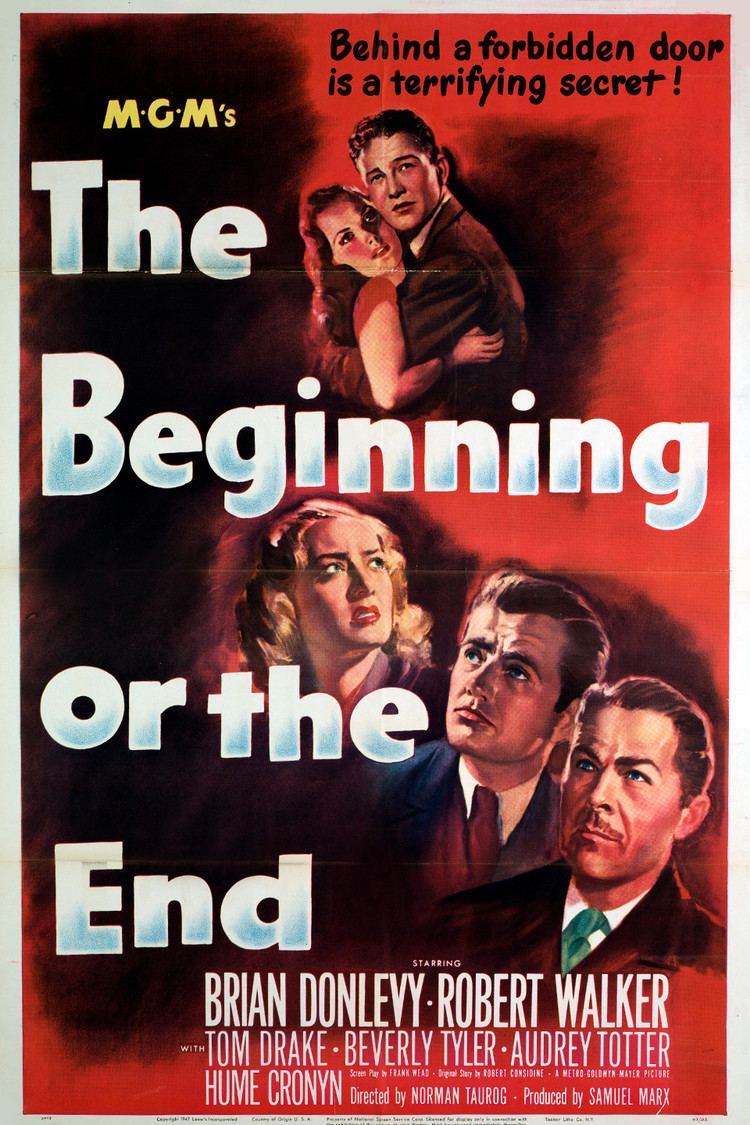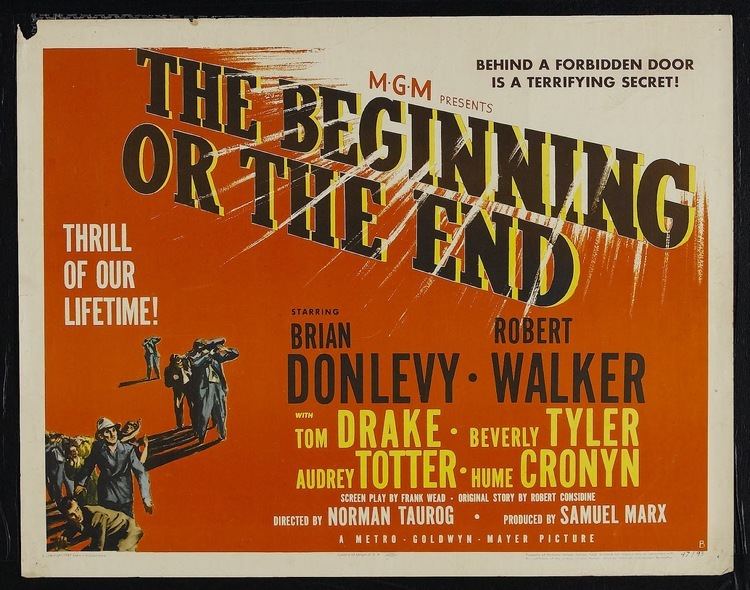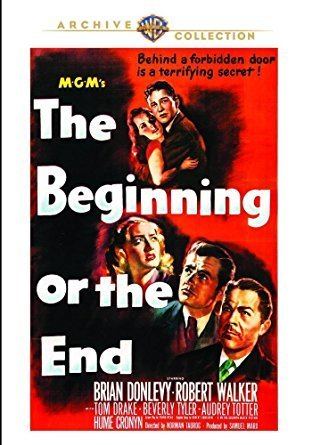The Beginning or the End
7 /10 1 Votes7
Duration Country United States | 7/10 IMDb Genre Biography, Drama, History Language English | |||||||||||||||||||||||||||||||||
 | ||||||||||||||||||||||||||||||||||
Release date March 7, 1947 (1947-03-07) Cast (Maj. Gen. Leslie R. Groves), Robert Walker (Col. Jeff Nixon), Tom Drake (Matt Cochran), Beverly Tyler (Anne Cochran), (Dr. J. Robert Oppenheimer), (Jean O'Leary)Similar movies | ||||||||||||||||||||||||||||||||||
The beginning or the end beginning
The Beginning or the End (1947) is an American docudrama film about the development of the atomic bomb in World War II, directed by Norman Taurog, starring Brian Donlevy and Hume Cronyn, and released by Metro-Goldwyn-Mayer (MGM). The film dramatizes the creation of the atomic bomb in the Manhattan Project and the bombing of Hiroshima.
Contents
- The beginning or the end beginning
- The beginning or the end trailer complete
- Plot
- Production
- Historical accuracy
- Reception
- References

The film originated in October 1945 as a project of actress Donna Reed and her high school science teacher, Edward R. Tompkins, who was a chemist at the Oak Ridge National Laboratory. Bob Considine wrote the treatment, which was sent to the MGM studio script writers. The title was supplied by President Harry S. Truman. At the time there was a legal requirement that permission be obtained to depict living well-known public figures. Many refused, but others, such as J. Robert Oppenheimer, co-operated. Major General Leslie R. Groves, Jr., the director of the Manhattan Project, was hired as a consultant for $10,000 (equivalent to $123,000 in 2016).

Although the filmmakers put considerable effort into historical accuracy, particularly in details, the film is known for some key distortions of history. An entirely fictional sequence was added in which Truman agonizes over whether to authorize the attack; anti-aircraft shells are shown bursting around the Enola Gay on its bombing run over Hiroshima; and it is said that leaflets were dropped on Hiroshima for ten days in advance of the mission warning the citizens of the forthcoming raid. The film received mixed reviews, and did not earn its money back.

The beginning or the end trailer complete
Plot

In 1945, physicist and atomic scientist Dr. J. Robert Oppenheimer (Hume Cronyn) praises the discovery of atomic energy, but also warns of its dangers. American scientists such as Matt Cochran (Tom Drake), working under the guidance of Dr. Enrico Fermi (Joseph Calleia) and Dr. Marré (Victor Francen), have split the atom, and essentially beaten the Germans in the race to create an atomic bomb. With the assistance of Albert Einstein (Ludwig Stössel), they inform President Franklin D. Roosevelt (Godfrey Tearle) that a monumental discovery has been made.

In 1941, with the United States at war, Roosevelt authorizes up to two billion dollars for the Manhattan Project to develop an atomic bomb. In December 1942, at the University of Chicago, under the watchful eyes of observers such as Colonel Jeff Nixon (Robert Walker) and international experts, scientists create the first chain reaction, under a stadium at the campus.
Nixon is assigned to General Leslie Groves (Brian Donlevy), who is placed in charge of the project. Groves has to bring together the scientific, industrial and defense communities to build the atomic bomb. In 1945, following the death of Roosevelt, the new president, Harry S. Truman (Art Baker), continues to support the atomic project, now moved to Los Alamos, New Mexico. When refined uranium-235 is obtained, the first atomic bomb is built and tested successfully in the New Mexico desert. Facing stiff resistance in the Pacific War, Truman orders the use of the atomic bomb against Japan in July 1945.
Cochran and Nixon are assigned to accompany the crew transporting the bomb to Tinian. While assembling the bomb, the scientist comes into contact with radioactive material and dies. The following day, on August 6, 1945, the Enola Gay, a Boeing B-29 Superfortress bomber, drops an atomic bomb on Hiroshima. After the mission, Nixon returns home to break the news of her husband's death to Cochran's wife.
Production
The idea for The Beginning or the End originated in October 1945 with Donna Reed, a Hollywood actor, and her high school science teacher, Edward R. Tompkins, a chemist at the Oak Ridge National Laboratory. According to The Hollywood Reporter issues of December 1945 and January 1946, MGM, Paramount and 20th Century Fox were all interested in making a film about the Manhattan Project. Paramount's Hal B. Wallis was already working on his own version, titled Top Secret, but agreed to merge his project with MGM's and hand over his story and research, offering to serve as an adviser on the MGM treatment in return for a fixed fee and a percentage of the box office gross.
The Beginning or the End had a number of working titles, including Atom Bomb, The Manhattan Project and Top Secret. Bob Considine was hired to produce a treatment, which he sent to the studio script writers. The script underwent a number of revisions, with Ayn Rand being one of the writers. Her contributions include the montage of Hitler's conquests, a sequence in which a dying informant sends a message to Albert Einstein, and the sequence in which President Franklin Roosevelt authorizes the Manhattan Project. Other writers involved with the script were Robert Smith, Frank "Spig" Wead, Norman Krasna, David Hawkins, John Lee Mahin and Glenn Tryon. Producer Samuel Marx wrote the opening narration. Marx and Donna Reed's husband Tony Owen met with President Harry S. Truman to secure his approval. At their meeting, Truman is reported to have said: "Gentlemen, make a motion picture. Tell the people of this nation that for them it is the beginning or the end," thereby supplying the movie with its title.
H. T. Wensel from the National Bureau of Standards, Tompkins, and W. Bradford Shank from the Los Alamos National Laboratory acted as technical advisers. Relations between MGM and the scientists soon became strained, as the scientists began asking for multiple script changes, and Tompkins eventually resigned. Oppenheimer sent David Hawkins, a philosophy professor from the University of California to act as a mediator between Marx and the scientists. Although the original intention was that a substantial sum of money would be donated to scientists' associations like the Federation of Atomic Scientists, in the end, no scientific organizations accepted any money. Tompkins received $100 (equivalent to $1,000 in 2016). At the time there was a legal requirement that permission be obtained to depict living well-known public figures. Lise Meitner, Niels Bohr and Sir James Chadwick all refused to allow their names to be used in The Beginning or the End, which Marx regarded as unfortunate, as it made the film's Manhattan Project scenes look like an all-American affair.
The loss of Bohr caused important sequences to be deleted. The script originally had Bohr, rescued from the Germans in Copenhagen, bring a shocked Oppenheimer news that the German nuclear weapon project was supplying expertise to its Japanese counterpart. A German U-boat carrying a fictional scientist travels to Japan where he joins the Japanese project in Hiroshima. Vannevar Bush objected to the way the script depicted him as having doubts about whether the atomic bomb could be built in time or could fit into an aircraft. Bush insisted that he never had any doubts. The script was changed to soften this. In the film, when Bush tells Roosevelt that he has a top secret matter to discuss, the President's dog Fala leaves the room.
Oppenheimer raised no objection to the sequence in the film in which he told Brigadier General Thomas Farrell that the odds of a runaway explosion destroying the planet were less than one in a million, although he let MGM know it never happened. The cultured Oppenheimer's main concern was that the script was poor, with characters that were "stilted, lifeless, and without purpose or insight."
Military technical advisers for The Beginning or the End included Colonel William A. Considine, Groves's assistant in charge of in charge of Security and Public Relations, Major Glen W. Landreth, Major Paul Van Sloun and Lieutenant Colonel Charles W. Sweeney, the pilot of Bockscar, the bomber that dropped the second atomic bomb on Nagasaki. Scientists were alarmed by reports that the dashing actor Clark Gable was being considered for the role of Groves, but were relieved when Brian Donlevy was cast in the role, as he normally played a villain. Indeed, most of the cast were best known for film noir : Hume Cronyn for The Postman Always Rings Twice; Joseph Calleia, for Gilda and Deadline at Dawn; and Ludwig Stössel for Fritz Lang's Cloak and Dagger. Groves's cooperation was secured by hiring him as a primary consultant, for $10,000 (equivalent to $123,000 in 2016). The portly Groves apparently had no objection to his portrayal by the slim and handsome Donlevy, except for the way in which he was shown bossing industrialists around. He had a scene in which he warned Roosevelt that the invasion of Japan would be opposed by Japanese nuclear weapons deleted.
Eleanor Roosevelt objected to the casting of Lionel Barrymore as her late husband, due to political remarks that Barrymore had made about the president in 1944. Marx delayed Barrymore's scenes while she had a chance to read and respond to a letter Barrymore sent her explaining that his remarks had been misinterpreted, but she was not placated, and Barrymore was replaced in the role by Godfrey Tearle. The War Department and the White House reviewed the script, and both asked for changes. The Army had a scene where an Army major made a pass at a girl deleted, as it felt that this was poor conduct for an officer.
The casual way that Truman and Groves were shown to decide to use the bomb, with Truman stating that "I think more of our American boys than I do of all our enemies", while accurate, troubled Walter Lippmann, who felt that it could lead to foreigners being fearful of atomic weapons being in American hands. An entirely fictional sequence was therefore added in which Truman agonizes over whether to authorize the attack or not. In it Truman asserts that dropping the bomb will shorten the war, and a "year less of war will mean life for ... from 300,000 to half a million of America's finest youth".
The motion picture censors asked for further cuts. Derogatory references to Mexicans were removed, as was an off-color joke about the effects of exposure to radioactive substances ("Is it true if you fool around with that stuff you don't like girls anymore?" "Not that I've noticed"), and one about politics ("I got it confidential−we're makin' the front ends of horses. We ship 'em to Washington to hook on to the other end.")
Principal photography for The Beginning or the End began on April 29, 1946, and continued until July 25 with retakes beginning on August 9, 1946. The production premiered in Washington, D.C. on February 19, 1947, with the national release of the film following on March 7, 1947.
Historical accuracy
The filmmakers put considerable effort into historical accuracy, particularly in details such as military uniforms and the details of the Enola Gay and its crew. Nine of the actors who portrayed the Enola Gay crew were actual veterans of World War II. The technical details of atomic processes and the bomb's design are wildly inaccurate by intention. In 1947, these details were highly classified. One inaccuracy, independent of necessary military secrecy, is the portrayal of anti-aircraft shells bursting around the aircraft on the bombing run, as the attack on Hiroshima was not opposed.
The film twice refers to specific leaflet drops on the target for ten days in advance of the mission warning the citizens of the forthcoming raid. "We've been dropping warning leaflets on them for ten days now", one crew member remarks, "That's ten days more warning than they gave us before Pearl Harbor." There was no leaflet specifically warning of an atomic attack. In his review in the Bulletin of the Atomic Scientists, physicist Harrison Brown called this "the most horrible falsification of history". Historians have debated whether any leaflets were dropped at all.
Reception
Although The Beginning or the End was the first film to depict the story of the atomic bomb, both critics and the public were confused by the attempt to merge real events in a docudrama form. Bosley Crowther of The New York Times commented, "... despite its generally able reenactments, this film is so laced with sentiment of the silliest and most theatrical nature that much of its impressiveness is marred." Variety described the film as a "portentous tale in broad strokes of masterful scripting and production", and a "sum credit of everybody concerned that the documentary values are sufficiently there without becoming static". In his Bulletin of the Atomic Scientists review, Harrison Brown considered the movie "poor", with a romantic angle "insipid in the extreme", but was most troubled by way scientific equipment was "over-glamorized" in the film, which he felt gave "a completely false impression of how scientists work." The review in Time was less positive, noting that, "even as entertainment ... the picture seldom rises above cheery imbecility."
According to MGM records, The Beginning or the End was made on a budget of $2,632,000 (equivalent to $32,325,000 in 2016), but earned $1,221,000 (equivalent to $14,996,000 in 2016) in the United States and Canada and $721,000 (equivalent to $8,855,000 in 2016) elsewhere, resulting in a loss to the studio of $1,596,000 (equivalent to $19,601,000 in 2016).
References
The Beginning or the End WikipediaThe Beginning or the End IMDb The Beginning or the End themoviedb.org
